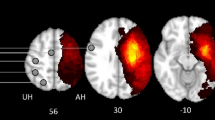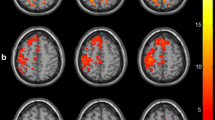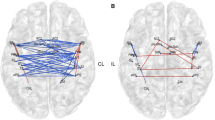Abstract
Introduction
It has been demonstrated that rehabilitative interventions can promote motor function recovery in stroke patients. However, little is known regarding the neural mechanisms that underlie the rehabilitation treatments. The aim of this study was to investigate the plasticity of intrinsic functional connectivity patterns that are associated with rehabilitation intervention in chronic stroke patients.
Methods
Twelve chronic stroke patients with subcortical lesions in the left motor pathway participated in a 4-week rehabilitation intervention and underwent resting-state functional magnetic resonance imaging (fMRI) scanning before and after the intervention. Both functional connectivity analyses of the ipsilesional (left) primary motor cortex (M1) and measurements of the lateralization index of the connectivity patterns were performed in both the stroke patients and healthy controls (HC).
Results
Compared with the HC, the decreased connectivity of the ipsilesional M1 with the contralesional sensorimotor cortex (SMC), bilateral supplementary motor areas, and inferior parietal lobule due to stroke were remarkably restored after the intervention. More specifically, the lateralization index of the bilateral SMC tends to be the normal level. Moreover, comparing post- with pre-intervention, we observed significantly increased connectivity of ipsilesional M1 with the contralesional M1 and medial superior frontal gyrus (mSFG). Additionally, the index of pre-intervention connectivity with the contralesional mSFG was positively correlated with motor improvement.
Conclusion
The impact of rehabilitation intervention on intrinsic functional connectivity patterns throughout the brain was measurable on resting-state fMRI, and systematic assessment of resting-state functional connectivity can provide prognostic insight for later motor improvement.




Similar content being viewed by others
Reference
Duncan PW, Goldstein LB, Matchar D, Divine GW, Feussner J (1992) Measurement of motor recovery after stroke. Outcome assessment and sample size requirements. Stroke; a J Cerebral Circ 23(8):1084–1089
Calautti C, Baron JC (2003) Functional neuroimaging studies of motor recovery after stroke in adults: a review. Stroke; A J Cereb Circ 34(6):1553–1566. doi:10.1161/01.str.0000071761.36075.a6
Loubinoux I, Carel C, Pariente J, Dechaumont S, Albucher JF, Marque P, Manelfe C, Chollet F (2003) Correlation between cerebral reorganization and motor recovery after subcortical infarcts. NeuroImage 20(4):2166–2180
Loubinoux I, Dechaumont-Palacin S, Castel-Lacanal E, De Boissezon X, Marque P, Pariente J, Albucher JF, Berry I, Chollet F (2007) Prognostic value of FMRI in recovery of hand function in subcortical stroke patients. Cereb Cortex (New York, NY: 1991) 17(12):2980–2987. doi:10.1093/cercor/bhm023
Rehme AK, Eickhoff SB, Wang LE, Fink GR, Grefkes C (2011) Dynamic causal modeling of cortical activity from the acute to the chronic stage after stroke. NeuroImage 55(3):1147–1158. doi:10.1016/j.neuroimage.2011.01.014
Tombari D, Loubinoux I, Pariente J, Gerdelat A, Albucher JF, Tardy J, Cassol E, Chollet F (2004) A longitudinal fMRI study: in recovering and then in clinically stable sub-cortical stroke patients. NeuroImage 23(3):827–839. doi:10.1016/j.neuroimage.2004.07.058
Cramer SC, Nelles G, Benson RR, Kaplan JD, Parker RA, Kwong KK, Kennedy DN, Finklestein SP, Rosen BR (1997) A functional MRI study of subjects recovered from hemiparetic stroke. Stroke; A J Cereb Circ 28(12):2518–2527
Pineiro R, Pendlebury S, Johansen-Berg H, Matthews PM (2002) Altered hemodynamic responses in patients after subcortical stroke measured by functional MRI. Stroke; A J Cereb Circ 33(1):103–109
Sun L, Yin D, Zhu Y, Fan M, Zang L, Wu Y, Jia J, Bai Y, Zhu B, Hu Y (2013) Cortical reorganization after motor imagery training in chronic stroke patients with severe motor impairment: a longitudinal fMRI study. Neuroradiology 55(7):913–925. doi:10.1007/s00234-013-1188-z
Ward NS, Brown MM, Thompson AJ, Frackowiak RS (2003) Neural correlates of motor recovery after stroke: a longitudinal fMRI study. Brain : J Neurol 126(Pt 11):2476–2496. doi:10.1093/brain/awg245
Biswal B, Yetkin FZ, Haughton VM, Hyde JS (1995) Functional connectivity in the motor cortex of resting human brain using echo-planar MRI. Magn Reson Med 34(4):537–541
Damoiseaux JS, Rombouts SA, Barkhof F, Scheltens P, Stam CJ, Smith SM, Beckmann CF (2006) Consistent resting-state networks across healthy subjects. Proc Natl Acad Sci U S A 103(37):13848–13853. doi:10.1073/pnas.0601417103
Greicius MD, Krasnow B, Reiss AL, Menon V (2003) Functional connectivity in the resting brain: a network analysis of the default mode hypothesis. Proc Natl Acad Sci U S A 100(1):253–258. doi:10.1073/pnas.0135058100
Seeley WW, Menon V, Schatzberg AF, Keller J, Glover GH, Kenna H, Reiss AL, Greicius MD (2007) Dissociable intrinsic connectivity networks for salience processing and executive control. J Neurosci 27(9):2349–2356. doi:10.1523/jneurosci.5587-06.2007
Park JY, Kim YH, Chang WH, Park CH, Shin YI, Kim ST, Pascual-Leone A (2014) Significance of longitudinal changes in the default-mode network for cognitive recovery after stroke. European J Neurosci 40(4):2715–2722. doi:10.1111/ejn.12640
van Hees S, McMahon K, Angwin A, de Zubicaray G, Read S, Copland DA (2014) A functional MRI study of the relationship between naming treatment outcomes and resting state functional connectivity in post-stroke aphasia. Hum Brain Mapp 35(8):3919–3931. doi:10.1002/hbm.22448
Yin D, Song F, Xu D, Peterson BS, Sun L, Men W, Yan X, Fan M (2012) Patterns in cortical connectivity for determining outcomes in hand function after subcortical stroke. PLoS One 7(12):e52727. doi:10.1371/journal.pone.0052727
Park CH, Chang WH, Ohn SH, Kim ST, Bang OY, Pascual-Leone A, Kim YH (2011) Longitudinal changes of resting-state functional connectivity during motor recovery after stroke. Stroke; J Cereb Circ 42(5):1357–1362. doi:10.1161/strokeaha.110.596155
Golestani AM, Tymchuk S, Demchuk A, Goodyear BG (2013) Longitudinal evaluation of resting-state FMRI after acute stroke with hemiparesis. Neurorehabil Neural Repair 27(2):153–163. doi:10.1177/1545968312457827
Barzel A, Ketels G, Tetzlaff B, Kruger H, Haevernick K, Daubmann A, Wegscheider K, Scherer M (2013) Enhancing activities of daily living of chronic stroke patients in primary health care by modified constraint-induced movement therapy (HOMECIMT): study protocol for a cluster randomized controlled trial. Trials 14:334. doi:10.1186/1745-6215-14-334
Braun SM, Beurskens AJ, Borm PJ, Schack T, Wade DT (2006) The effects of mental practice in stroke rehabilitation: a systematic review. Arch Phys Med Rehabil 87(6):842–852. doi:10.1016/j.apmr.2006.02.034
Brunnstrom S (1966) Motor testing procedures in hemiplegia: based on sequential recovery stages. Phys Ther 46(4):357–375
Oldfield RC (1971) The assessment and analysis of handedness: the Edinburgh inventory. Neuropsychologia 9(1):97–113
Fugl-Meyer AR, Jaasko L, Leyman I, Olsson S, Steglind S (1975) The post-stroke hemiplegic patient. 1. A method for evaluation of physical performance. Scand J Rehabil Med 7(1):13–31
Song XW, Dong ZY, Long XY, Li SF, Zuo XN, Zhu CZ, He Y, Yan CG, Zang YF (2011) REST: a toolkit for resting-state functional magnetic resonance imaging data processing. PLoS One 6(9):e25031. doi:10.1371/journal.pone.0025031
Cordes D, Haughton VM, Arfanakis K, Carew JD, Turski PA, Moritz CH, Quigley MA, Meyerand ME (2001) Frequencies contributing to functional connectivity in the cerebral cortex in "resting-state" data. AJNR Am J Neuroradiol 22(7):1326–1333
Wang L, Yu C, Chen H, Qin W, He Y, Fan F, Zhang Y, Wang M, Li K, Zang Y, Woodward TS, Zhu C (2010) Dynamic functional reorganization of the motor execution network after stroke. Brain : J Neurol 133(Pt 4):1224–1238. doi:10.1093/brain/awq043
Hampson M, Peterson BS, Skudlarski P, Gatenby JC, Gore JC (2002) Detection of functional connectivity using temporal correlations in MR images. Hum Brain Mapp 15(4):247–262
Tang Q, Li G, Liu T, Wang A, Feng S, Liao X, Jin Y, Guo Z, He B, McClure MA, Xing G, Mu Q (2015) Modulation of interhemispheric activation balance in motor-related areas of stroke patients with motor recovery: systematic review and meta-analysis of fMRI studies. Neurosci Biobehav Rev 57:392–400. doi:10.1016/j.neubiorev.2015.09.003
Calautti C, Naccarato M, Jones PS, Sharma N, Day DD, Carpenter AT, Bullmore ET, Warburton EA, Baron JC (2007) The relationship between motor deficit and hemisphere activation balance after stroke: a 3T fMRI study. NeuroImage 34(1):322–331. doi:10.1016/j.neuroimage.2006.08.026
Marshall RS, Perera GM, Lazar RM, Krakauer JW, Constantine RC, DeLaPaz RL (2000) Evolution of cortical activation during recovery from corticospinal tract infarction. Stroke; J Cereb Circ 31(3):656–661
Woo CW, Krishnan A, Wager TD (2014) Cluster-extent based thresholding in fMRI analyses: pitfalls and recommendations. NeuroImage 91:412–419. doi:10.1016/j.neuroimage.2013.12.058
Carter AR, Astafiev SV, Lang CE, Connor LT, Rengachary J, Strube MJ, Pope DL, Shulman GL, Corbetta M (2010) Resting interhemispheric functional magnetic resonance imaging connectivity predicts performance after stroke. Ann Neurol 67(3):365–375. doi:10.1002/ana.21905
Calautti C, Leroy F, Guincestre JY, Baron JC (2001) Dynamics of motor network overactivation after striatocapsular stroke: a longitudinal PET study using a fixed-performance paradigm. Stroke; J Cereb Circ 32(11):2534–2542
Gerloff C, Bushara K, Sailer A, Wassermann EM, Chen R, Matsuoka T, Waldvogel D, Wittenberg GF, Ishii K, Cohen LG, Hallett M (2006) Multimodal imaging of brain reorganization in motor areas of the contralesional hemisphere of well recovered patients after capsular stroke. Brain : J Neurol 129(Pt 3):791–808. doi:10.1093/brain/awh713
Lotze M, Markert J, Sauseng P, Hoppe J, Plewnia C, Gerloff C (2006) The role of multiple contralesional motor areas for complex hand movements after internal capsular lesion. J Neurosci 26(22):6096–6102. doi:10.1523/jneurosci.4564-05.2006
Murase N, Duque J, Mazzocchio R, Cohen LG (2004) Influence of interhemispheric interactions on motor function in chronic stroke. Ann Neurol 55(3):400–409. doi:10.1002/ana.10848
Ward NS (2005) Mechanisms underlying recovery of motor function after stroke. Postgrad Med J 81(958):510–514. doi:10.1136/pgmj.2004.030809
Fox MD, Snyder AZ, Vincent JL, Raichle ME (2007) Intrinsic fluctuations within cortical systems account for intertrial variability in human behavior. Neuron 56(1):171–184. doi:10.1016/j.neuron.2007.08.023
Azari NP, Binkofski F, Pettigrew KD, Freund HJ, Seitz RJ (1996) Enhanced regional cerebral metabolic interactions in thalamic circuitry predicts motor recovery in hemiparetic stroke. Hum Brain Mapp 4(4):240–253. doi:10.1002/(SICI)1097-0193(1996)4:4<240::AID-HBM2>3.0.CO;2-3 10.1002/(sici)1097-0193(1996)4:4<240::aid-hbm2>3.0.co;2-3
Leiguarda RC, Marsden CD (2000) Limb apraxias: higher-order disorders of sensorimotor integration. Brain : J Neurol 123(Pt 5):860–879
Talati A, Hirsch J (2005) Functional specialization within the medial frontal gyrus for perceptual go/no-go decisions based on "what," "when," and "where" related information: an fMRI study. J Cogn Neurosci 17(7):981–993. doi:10.1162/0898929054475226
Jeannerod M, Frak V (1999) Mental imaging of motor activity in humans. Curr Opin Neurobiol 9(6):735–739
Perrett SP, Ruiz BP, Mauk MD (1993) Cerebellar cortex lesions disrupt learning-dependent timing of conditioned eyelid responses. J Neurosci 13(4):1708–1718
He BJ, Snyder AZ, Vincent JL, Epstein A, Shulman GL, Corbetta M (2007) Breakdown of functional connectivity in frontoparietal networks underlies behavioral deficits in spatial neglect. Neuron 53(6):905–918. doi:10.1016/j.neuron.2007.02.013
Liu J, Qin W, Zhang J, Zhang X, Yu C (2015) Enhanced interhemispheric functional connectivity compensates for anatomical connection damages in subcortical stroke. Stroke; J Cereb Circ 46(4):1045–1051. doi:10.1161/strokeaha.114.007044
Acknowledgments
This research was supported by the China National Nature Science Foundation (grant no. 81471651), the China National Nature Science Young Foundation (grant no. 81401859), the 12th Five-Year Plan supporting project of Ministry of Science and Technology of the People’s Republic of China (grant no. 2013BAI10B03), the Shanghai Zhabei District Health Bureau (grant no. 2014MS06) and the Shanghai Commission of Healthy and Family Planning (grant no. 201440634). We would like to thank all of the volunteers and stroke patients for their participation in this study.
Author information
Authors and Affiliations
Corresponding author
Ethics declarations
We declare that all human and animal studies have been approved by the Institutional Ethics Committee of East China Normal University, Shanghai, China, and have therefore been performed in accordance with the ethical laid down in the 1964 Declaration of Helsinki and its later amendments. We declare that all patients gave informed consent prior to inclusion in this study.
Conflict of interest
We declare that we have no conflict of interest.
Additional information
XZ and LS are joint first authors and contributed equally to this study.
Electronic supplementary material
Below is the link to the electronic supplementary material.
Fig. S1
Comparison of the functional connectivity of the ipsilesional M1 between stroke patients (at both pre- and post-intervention) and HC. (DOCX 2500 kb)
Rights and permissions
About this article
Cite this article
Zheng, X., Sun, L., Yin, D. et al. The plasticity of intrinsic functional connectivity patterns associated with rehabilitation intervention in chronic stroke patients. Neuroradiology 58, 417–427 (2016). https://doi.org/10.1007/s00234-016-1647-4
Received:
Accepted:
Published:
Issue Date:
DOI: https://doi.org/10.1007/s00234-016-1647-4




